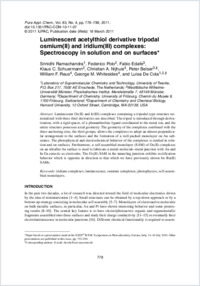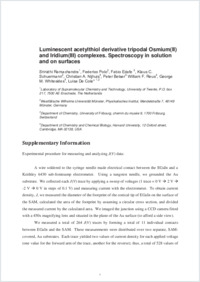Luminescent acetylthiol derivative tripodal osmium(II) and iridium(III) complexes: Spectroscopy in solution and on surfaces
- Ramachandra, Srinidhi Laboratory of Supramolecular Chemistry and Technology, University of Twente, Enschede, The Netherlands
- Polo, Federico Westfälische Wilhelms-Universität Münster, Physikalisches Institut, Münster, Germany
- Edafe, Fabio Department of Chemistry, University of Fribourg, Switzerland
- Schuermann, Klaus C. Westfälische Wilhelms-Universität Münster, Physikalisches Institut, Münster, Germany
- Nijhuis, Christian A. Department of Chemistry and Chemical Biology, Harvard University, Cambridge, USA
- Belser, Peter Department of Chemistry, University of Fribourg, Switzerland
- Reus, William F. Department of Chemistry and Chemical Biology, Harvard University, Cambridge, USA
- Whitesides, George M. Department of Chemistry and Chemical Biology, Harvard University, Cambridge, USA
- Cola, Luisa De Laboratory of Supramolecular Chemistry and Technology, University of Twente, Enschede, The Netherlands - Westfälische Wilhelms-Universität Münster, Physikalisches Institut, Münster, Germany
-
18.03.2011
Published in:
- Pure and Applied Chemistry. - 2011, vol. 4, no. 83, p. 779-799
English
Luminescent Os(II) and Ir(III) complexes containing a tripodal-type structure terminalized with three thiol derivatives are described. The tripod is introduced through derivatization, with a rigid spacer, of a phenanthroline ligand coordinated to the metal ion, and the entire structure possesses axial geometry. The geometry of the complexes combined with the three anchoring sites, the thiol groups, allows the complexes to adopt an almost perpendicular arrangement to the surfaces and the formation of a well-packed monolayer on Au substrates. The photophysical and electrochemical behavior of the complexes is studied in solution and on surfaces. Furthermore, a self-assembled monolayer (SAM) of Os(II) complexes on an ultraflat Au surface is used to fabricate a metal–molecule–metal junction with Au and In Ga eutectic as electrodes. The Os(II) SAM in the tunneling junction exhibits rectification behavior which is opposite in direction to that which we have previously shown for Ru(II) SAMs.
- Faculty
- Faculté des sciences et de médecine
- Department
- Département de Chimie
- Language
-
- English
- Classification
- Chemistry
- License
-
License undefined
- Identifiers
-
- RERO DOC 24965
- DOI 10.1351/PAC-CON-10-11-07
- Persistent URL
- https://folia.unifr.ch/unifr/documents/301972
Other files
Statistics
Document views: 124
File downloads:
- Document: 116
- Supplementary material: 140

